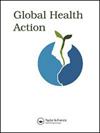参加瑞典语课程的移民对瑞典青年诊所的认识和利用情况:一项横断面研究。
IF 2.2
3区 医学
Q2 PUBLIC, ENVIRONMENTAL & OCCUPATIONAL HEALTH
引用次数: 0
摘要
背景以前的研究强调了在瑞典青年诊所(YCs)就医方面存在的不平等现象。目标评估参加瑞典语课程的移民对瑞典青年诊所的了解和利用情况,并探讨相关因素。方法这项横断面研究涉及 1112 名 15-65 岁的移民。分析样本包括 642 名(57%)参与者,他们回答了主要结果问题 "对青年中心的认识"。研究采用贝叶斯方法进行描述性统计、双变量和多变量对数二叉回归分析,以总结数据并确定与移民对青年中心的认知和使用相关的因素。此外,23%的目标群体(15-25 岁)曾经去过青年旅舍。在描述性分析和双变量分析中,社会人口统计学因素对青年中心的认知和使用情况的影响非常明显。本研究强调了参加瑞典语课程的移民对青年中心的了解程度,以及 15-25 岁人群对青年中心的利用情况,这可能会影响他们获得关键服务和资源。要满足不同社会人口群体的特殊需求,并确保公平获取青年中心的信息和服务,就必须采取有针对性的干预措施和可持续战略,而不是一次性干预措施。本文章由计算机程序翻译,如有差异,请以英文原文为准。
Awareness and utilization of Swedish youth clinics among migrants enrolled in Swedish language programmes: a cross-sectional study.
BACKGROUND
Previous research has highlighted inequalities in access to Swedish youth clinics (YCs). These inequalities exist not only between non-migrant and young migrant populations but also within various migrant groups.
OBJECTIVES
To assess awareness and utilization of Swedish YCs among migrants enrolled in Swedish language programmes and explore associated factors.
METHODS
This cross-sectional study involved 1,112 migrants aged 15-65. The analytical sample included 642 (57%) participants who answered the main outcome question about awareness of YCs. Descriptive statistics, bivariate, and multivariate log-binomial regression analyses using a Bayesian approach were applied to summarize the data and identify factors associated with awareness and utilization of YCs among migrants.
RESULTS
The results revealed that 30% of all participants and 40% of the participants aged 15-25 years had heard of YCs. Additionally, 23% of the target group (15-25 years) had ever visited one. During descriptive and bivariate analyses, socio-demographic variations were evident in YCs' awareness and utilization. However, in multivariate analyses, only the associations between awareness and year of arrival, and YCs' utilization and year of arrival and type of residence permit, remained statistically significant.
CONCLUSION
This study highlights the level of awareness of YCs among migrants attending Swedish language programmes and their utilization by those aged 15-25 years, potentially impacting their access to crucial services and resources. Targeted interventions and sustainable strategies beyond one-time interventions are essential to address the specific needs of different socio-demographic groups and ensure equitable access to YCs' information and services.
求助全文
通过发布文献求助,成功后即可免费获取论文全文。
去求助
来源期刊

Global Health Action
PUBLIC, ENVIRONMENTAL & OCCUPATIONAL HEALTH-
CiteScore
5.10
自引率
3.80%
发文量
108
审稿时长
16 weeks
期刊介绍:
Global Health Action is an international peer-reviewed Open Access journal affiliated with the Unit of Epidemiology and Global Health, Department of Public Health and Clinical Medicine at Umeå University, Sweden. The Unit hosts the Umeå International School of Public Health and the Umeå Centre for Global Health Research.
Vision: Our vision is to be a leading journal in the global health field, narrowing health information gaps and contributing to the implementation of policies and actions that lead to improved global health.
Aim: The widening gap between the winners and losers of globalisation presents major public health challenges. To meet these challenges, it is crucial to generate new knowledge and evidence in the field and in settings where the evidence is lacking, as well as to bridge the gaps between existing knowledge and implementation of relevant findings. Thus, the aim of Global Health Action is to contribute to fuelling a more concrete, hands-on approach to addressing global health challenges. Manuscripts suggesting strategies for practical interventions and research implementations where none already exist are specifically welcomed. Further, the journal encourages articles from low- and middle-income countries, while also welcoming articles originated from South-South and South-North collaborations. All articles are expected to address a global agenda and include a strong implementation or policy component.
 求助内容:
求助内容: 应助结果提醒方式:
应助结果提醒方式:


